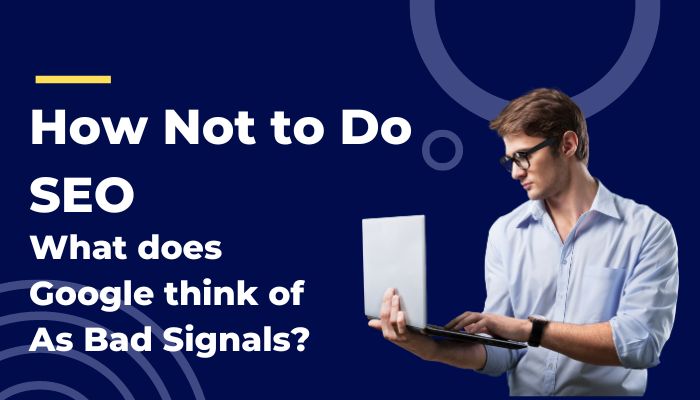Learn all about how not to do SEO, avoid SEO red flags and leverage the power of SEO to rank higher.
 With the ever-changing world of search engine optimization, one needs to be updated with knowledge regarding practices that would hurt your website’s search engine ranking. Google itself has been clear on some practices that it considers “not good signals” for its algorithms. This best practice guide aims to ensure that webmasters and SEO professionals steer clear of these common mistakes and get them to set up shop-on strategies in line with what Google perceives as useful and friendly to their users. In-depth insight into which signals Google flags as poor follows, along with adjustments you can make in your SEO.
With the ever-changing world of search engine optimization, one needs to be updated with knowledge regarding practices that would hurt your website’s search engine ranking. Google itself has been clear on some practices that it considers “not good signals” for its algorithms. This best practice guide aims to ensure that webmasters and SEO professionals steer clear of these common mistakes and get them to set up shop-on strategies in line with what Google perceives as useful and friendly to their users. In-depth insight into which signals Google flags as poor follows, along with adjustments you can make in your SEO.
What Are Poor Signals?
Besides the best practices, Google’s guide gives a number of activities and factors that obviously do not contribute to enhancing a website’s performance in search. Knowing them empowers one for the finetuning of SEO strategies on what matters in really enhancing user experience and site quality.
1. Excessive Keyword Stuffing
While keywords are essential in SEO, keyword stuffing is really counterproductive. The algorithms of Google understand the context and intent of queries without keyword stuffing. Websites which overstuff their content with keywords risk penalties for manipulating search rankings.
2. Low-Quality Content
That includes thin, inaccurate, or irrelevant content, content that is a poor signal. Explaining further and emphasizing, Google will reward high-quality, information-rich content. And, in return, thin content. There’s inadequate or no relevant content present, and the page badly explains what the user is searching for. Such pages do not rank very well in search results.
3. Intrusive Ads
Websites that put aggressive ad use over user experience send the wrong signal to Google. This will include intrusive display ads that would give way to a ranking downgrade. But, they might be large popup windows, video ads blaring by themselves, or even trickery in general.
4. Poor Mobile Usability
For the mobile-first world of today, if a website isn’t optimized for mobile devices, that significantly corresponds to a poor user experience and is thus downrated by Google. Thus, having a mobile-friendly website becomes more important than ever as the majority of users log in through their handheld devices.
5. Manipulative Link Practices
What can be a major red flag to Google is participating in link schemes or buying links, which has been done over and over to improve rankings. Also, the stress has always got to be on gaining links through good content and organic relationships, not through manipulative schemes.
6. Irrelevant Keywords
Stuffing your titles with a lot of keywords that have nothing to do with the content only serves to raise traffic. Moreover, doing this will frustrate users and make Google think that the site has less trustworthiness and relevance.
How to Respond to Google’s Guidelines
1. Focus on Quality Content
At the heart of any natural SEO strategy lies content that truly serves user intent with in-depth research during that very moment. Content should at least answer questions, solve problems, and provide value, all these will increase engagement, organically link and get shared.
2. Enhance User Experience
Make sure that users can move around easily on your site, quickly and without hassle, on all devices, including mobile ones. Also, eliminating intrusive ads and improving page load times are two steps toward that end.
3. Maintain Ethical SEO Practices
Sticking to white-hat SEO methods such as following proper keyword usage, natural link building, and adhering to the laid-down Webmaster guidelines ensures you are always free of such issues. Avoid shortcuts and instead work on long-term strategies.
Audit Your SEO Performance on a Regular Basis
Track the performance with tools such as Google Analytics and Google Search Console. A regular audit gives insights into mistakes or problems that could be dragging down search rankings.
Keeping pace with Google’s guidelines will enable and enhance your website’s SEO ranking. It would become easier to shape the strategy in a ‘quality-driven’ sense: content, user experience, and work in ethical SEO practices, not when you are enabled with insights on what poor signals look like according to Google. This would ensure that you not only do what is expected by Google but also provide value to your audience via your website, thus being sure to win from both sides in your digital marketing endeavours.
Also Read: An Ideal Mix of SEO with Content Marketing: Driving Digital Success.

